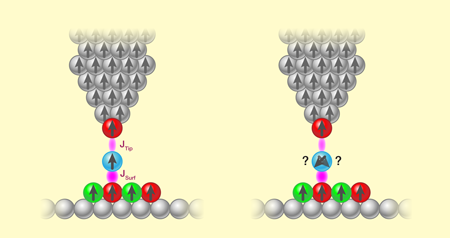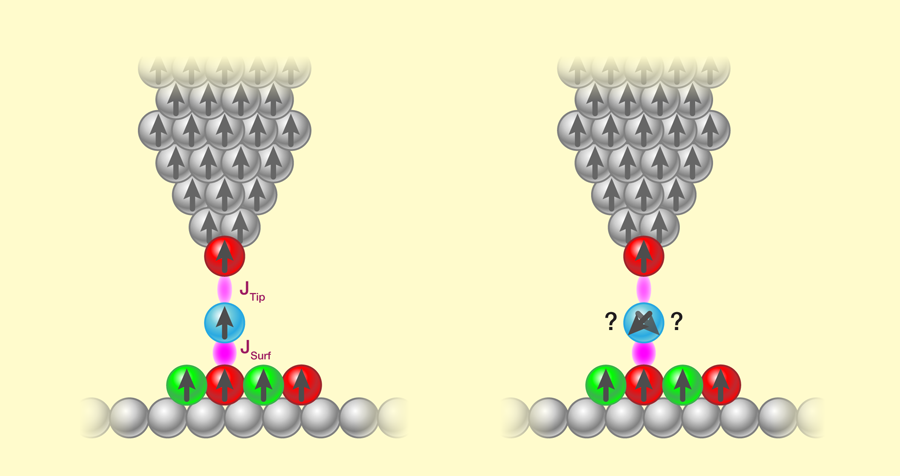Magnetic Friction is a Sticky Business
Friction is ubiquitous; without it even simple tasks would be impossible. Don’t believe it? Just try setting your drink on a frozen tabletop in an ice cave. However, as commonplace as friction is in our environment, physicists have found it challenging to derive friction from the fundamental laws of physics. In Physical Review Letters, Boris Wolter at the University of Hamburg, Germany, and his colleagues take a step in this direction by determining the contribution of a single atom’s spin to the friction it experiences as it slides across a magnetic surface [1].
The field of physics that tries to understand friction is called tribology. The central problem in tribology is to connect an observed frictional force between two contacting materials with the contact area (i.e., how many atoms are touching) and the physical, chemical, and mechanical properties of the materials. Needless to say, these quantities are really hard to measure in everyday materials because they have rough or contaminated surfaces, to name just a couple of the complicating factors.
Scanning probe microscopes, in which a tip of a few atoms in width can be brought in close proximity to, or in direct contact with, a surface, have been allowing researchers to take a new approach to tribology and focus on the nanoscale. Standard surface techniques are sufficient for preparing a smooth, clean region of a surface that is a few hundred nanometers in size, and atomic sized contacts can home in on these regions. In particular, atomic force microscopy (AFM) can directly measure the vertical and lateral forces between materials and has helped develop microscopic models of friction. In a sense, scanning probe tools have created a renaissance of interest in friction [2].
So what causes friction on such well-controlled surfaces? The answer depends strongly on the chemical and physical properties of the materials. Let’s explore it with the smallest possible contact area between two surfaces: a single metal atom adsorbed on a metal surface and the sharp metallic needle of a scanning probe tool. Such contacts have been investigated with scanning tunneling microscopes (STMs), as well as with AFM. For example, it was shown that for electronically smooth surfaces, the lateral forces for sliding certain adsorbed metal atoms is in the range of a few hundred piconewtons (pN), while the vertical forces are about an order of magnitude larger [3].
Utilizing scanning probe geometries, it is possible, with a clever trick, to determine how electrons in a metal contribute to friction: compare the friction on the surface of a normal metal with that of a superconductor [4]. In a superconductor, electrons pair up, and it costs a certain amount of energy to break them apart, which means these electrons aren’t available to take up the energy lost in a frictional process. Researchers found that the friction in the superconducting state was much lower than in the normal metal state, in which the electrons and the phonons together result in a higher friction coefficient.
So electrons can contribute to friction, which brings us to the interesting possibility that the magnetic degree of freedom, such as the magnetic moment on an atom, can also influence friction [5]. But is there a trick similar to the one used to compare friction in the superconducting versus normal metal state? This is what Wolter et al. have demonstrated in their current work [1]. They measure the friction for sliding a magnetic atom (cobalt) on an antiferromagnetic surface with an STM (Fig. 1). In an antiferromagnet, the spins of neighboring atoms point in opposite directions. Correspondingly, Wolter et al. see the friction become larger and smaller when sliding an atom over the surface of such an antiferromagnetic material.
A few words are in order to describe some of the details of this novel approach. Wolter et al. use spin-polarized STM to deduce the varying friction on the antiferromagnetic surface. But STM, which typically measures the small tunneling current between the tip and the surface, is not inherently sensitive to forces, including friction, so how can this tool offer a way to measure magnetic friction?
The answer is that STM can identify how strongly the atom binds to the surface as it moves to different points, and this information can be interpreted in terms of the forces that resist the motion of the atom. When an STM tip is brought close to an atom adsorbed on a surface, the end atom on the apex of the tip exerts an attractive or repulsive force (a sort of controlled chemical bond) on the adsorbate. On the surfaces of many materials, this force can be used to move the adsorbate laterally [6,7,3]. (Moving atoms in this way has a long history, beginning with the demonstration by Don Eigler and co-workers that they could spell the letters “IBM” on a surface, via atom manipulation [6].) In this mode, the adsorbate stays attached to one binding site on the surface until the force from the tip becomes so large that it hops to the adjacent stable binding site. A map of how strong the tip force needs to be to move the atom can, in turn, give a complex “image” of the binding sites on the surface [8].
Wolter et al. apply this technique to moving cobalt (Co) atoms over a single layer of antiferromagnetic manganese (Mn) deposited on a tungsten (W) substrate (Fig. 1). Co binds ferromagnetically to the nearest Mn atoms [9] and if Wolter et al. use a normal metal tip to drag the Co across the manganese surface, they find a manipulation image that is similar to those reported before [8]. However, if they use a spin-polarized tip that weakly couples (magnetically) to the Co atom, the manipulation image reveals the magnetic nature of the Mn layer: half the binding sites are imaged as small (weak) and the other half as large (strong), indicating a varying degree of stability of the Co adsorbate on these binding sites.
To transfer this imaging contrast into forces and hence information about magnetic friction, Wolter et al. had to model both the forces between all the atoms involved and a small number of parameters characterizing the magnetic interactions between the atoms. With this model, they find a local energy landscape for the Co atom, which depends on chemical and magnetic interactions, as the tip is moved laterally: The spin of the Co atom flips in accordance with the spin of the underlying, dominant Mn atom. This results in some binding sites where the magnetic coupling to the tip cannot be fulfilled (the Co spin is “frustrated”), and these sites become the less preferred binding sites. The authors find that a lateral force on the order of pN is needed to move the Co from site to site, but this force can vary by a factor of , depending on the relative magnetic alignment of Co and underlying Mn atoms. From this knowledge of the lateral forces, the authors determine the energy loss per binding site as the Co atom is moved along the surface (the magnetic atom has to flip its spin at every jump, which dissipates energy.)
Magnetic interaction energies are often considered to be much smaller than chemical energies. However, Wolter and co-workers show that this does not have to be the case for the lateral friction between magnetic materials. Their work thus adds a new trick to the tribologists’ bag—a trick that allows the comparison of friction parameters for magnetic and nonmagnetic nanocontacts. In the long run, researchers will need to scale up these measurements, which give the energy loss per atom, and figure out if they result in the same friction parameters that are used to describe macroscopic objects.
References
- B. Wolter, Y. Yoshida, A. Kubetzka, S-W. Hla, K. von Bergmann, and R. Wiesendanger, ”Spin Friction Observed on the Atomic Scale,” Phys. Rev. Lett. 109, 116102 (2012)
- M. Urbakh and E. Meyer, “Nanotribology: The Renaissance of Friction,” Nature Mater. 9, 8 (2010)
- M. Ternes, C. P. Lutz, C. F. Hirjibehedin, F. J. Giessibl, and A. J. Heinrich, “The Force Needed to Move an Atom on a Surface,” Science 319, 1066 (2008)
- M. Kisiel, E. Gnecco, U. Gysin, L. Marot, S. Rast, and E. Meyer, “Suppression of Electronic Friction on Nb Films in the Superconducting State,” Nature Mater. 10, 119 (2011)
- D. Kadau, A. Hucht, and D. E. Wolf, “Magnetic Friction in Ising Spin Systems,” Phys. Rev. Lett. 101, 137205 (2008)
- D. M. Eigler and E. K Schweizer, “Positioning Single Atoms with a Scanning Tunneling microscope,” Nature 344, 524 (1990)
- L. Bartels, G. Meyer, and K.-H. Rieder, “Basic Steps of Lateral Manipulation of Single Atoms and Diatomic Clusters with a Scanning Tunneling Microscope Tip,” Phys. Rev. Lett. 79, 697 (1997)
- J. A. Stroscio and R. J. Celotta, “Controlling the Dynamics of a Single Atom in Lateral Atom Manipulation,” Science 306, 242 (2004)
- D. Serrate et al., “Imaging and manipulating the spin direction of individual atoms,” Nature Nanotech. 5, 350 (2010)





